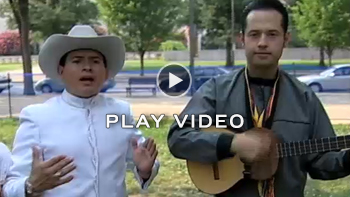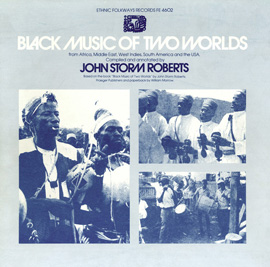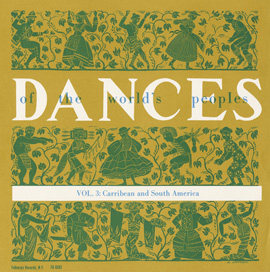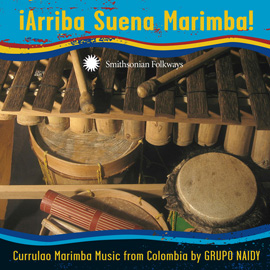Summary
This lesson investigates life on the Colombian Orinoco Plains through the exploration of Joropo Music. Activities include Spanish attentive listening, cultural enrichment, and musical interaction through singing, playing, and moving.
Suggested Grade Levels: 6-8
Country: Colombia
Region: South America
Culture Group: Colombian
Genre: Joropo
Instruments: Maracas, Shakers
Language: Spanish
Co-Curricular Areas: Social Studies, Spanish
National Standards: 1, 2, 3, 6, 8, 9
Prerequisites: None
Objectives:
- Listening (to instruments, beat, vocalization)
- Singing (partial melodies)
- Playing (shaker rhythms)
- Moving (to instrumental interludes, beat)
- Writing (an original “fast song” verse)
- Becoming acquainted with the people of the Orinoco plains; their language, location, and culture
- Exploring the female role in Joropo music
- Comparing “fast song contests” to other forms of nonviolent musical competitions
Material:
- “Llanero sí soy llanero” by Grupo Cimarrón, (SFW40515_101)
- Video: Instrument demonstration: Grupo Cimarrón perform "Y soy llanero" (And I Am a Plainsman)
- “Pajarillo” by Grupo Cimarrón, (SFW40515_118)
- “Soy llanero pelo liso” by Grupo Cimarrón, (SFW40515_117)
- “María Laya” by Grupo Cimarrón, (SFW40515_113)
- Album details & Liner Notes of Sí, soy llanero: Joropo Music from the Orinoco Plains of Colombia (SFW40515)
- Profile and video of Ana Veydó
- “Vine a defender lo mio” by Grupo Cimarrón
- Album details & Liner Notes
- Maps of South America and Colombia
- Shakers
- Paper and writing utensils
- Attentive listening worksheet
- Vocabulary visual aids (optional)
Lesson Segments:
- “Llanero, sí soy llanero” (National Standards 1, 2, 6, 9)
- “Pajarillo” (National Standards 2, 6, 9)
- “Soy llanero pelo liso” (National Standards 6, 8, 9)
- “María Laya” (National Standards 1, 6, 8, 9)
- “Vine a defender lo mío” (National Standards 1, 2, 3, 6, 8, 9)

“Llanero sí soy llanero”
from Sí, soy llanero: Joropo Music from the Orinoco Plains of Colombia (2004) | SFW40515
“Pajarillo”
“Soy llanero pelo liso”
“María Laya”
1. “Llanero, sí soy llanero” (Plainsman, yes I am a plainsman)
- Listen to the “Llanero, sí soy llanero” recording.
- Keep the pulse by patting the beat on your lap
- Sing along with the singer’s long held out notes
- “Air-play” the interlude passage of the cuatro guitar
- Using shakers, imitate the maracas player during the interlude passage that does not have singing
- Divide into two groups, switching from cuatro and shaker during the introduction and interlude
- See map of South America.
- Find Colombia
- See map of Colombia.
- Find Orinoco River and Plains
- Consider origin of the Orinoco River in Venezuela: Similar lifestyles in southern Venezuela
- Explore the origins of Joropo Music.
- Consider the reason for certain themes of joropo music such as: cattle, horses, music, and romance
Assessment:
Are students able to keep the steady pulse? Are students able to sing along with the held notes? Are students able to imitate the maracas? Are students able to discuss the material in an age appropriate manner?
2. “Pajarillo” (Little Bird)
- Listen to the “Pajarillo” recording.
- Students draw their version of what’s happening in the song or what their little bird looks like based on the music
- Use body movement to imitate the shaker interlude (may need to repeat this section of the song several times)
- Imitate the shaker interlude with vocalization or percussive sounds of the body
- Discuss instrumentation of Joropo music.
- Cuatro Guitar
- Maracas
- Harp
- Bandola Guitar
- String Bass
- Consider importance of voice, guitar and maracas on the plains
- Watch video of performance on these instruments: Grupo Cimarrón perform "Y soy llanero" (And I Am a Plainsman)
- “Pajarillo” contains improvisatory playing by Cuatro guitar, maracas and string bass
- Raise hands when you hear and can identify solos of each of the instruments
Assessment:
Are students able to draw their interpretation of the music? Are students able to imitate the shakers? Can students identify which instruments are improvising? Are students able to discuss the material in an age appropriate manner?
3. “Soy llanero pelo liso” (I am a straight-haired plainsman)
- Listen to the “Soy llanero pelo liso” recording.
- Complete Attentive listening activity: Fill in the blanks (see attached worksheet)
- Consider a vocabulary lesson for other words used in the song
- Consider meaning of this man’s life on the plains and its relationship to the song.
Assessment:
Are students able to successfully complete the worksheet? Are students able to discuss the material in an age appropriate manner?
4. “María Laya”
- Listen to the “María Laya” recording.
- Keep the pulse by patting the beat on your lap
- Hum along with the singer
- Consider a vocabulary lesson for words used in the song (ex. Adjectives: bonita, rica y hermosa)
- Consider the style of vocalization
- Sing along using words for the 3rd verse (try imitating the vocalization style while singing the 3rd verse)
-
Me han dicho que es muy bonita
que es rica y es muy hermosa
yo deseaba conocer a esa mujer
pa'ver si la hacía mi esposaI have been told that she is very pretty
That she is rich and very beautiful
I desired to meet that woman
To see if I could make her my wife - Consider that one of the most renowned joropo singers is a woman: Ana Veydó (see liner notes of album for Biographical information).
- Watch video: Ana Veydó discusses how women have changed the face of música llanera
Assessment:
Are students able to keep the steady beat and hum along with the singer? Are students able to mimic the vocal style? Are students able to discuss the material in an age appropriate manner?
5. “Vine a defender lo mío”
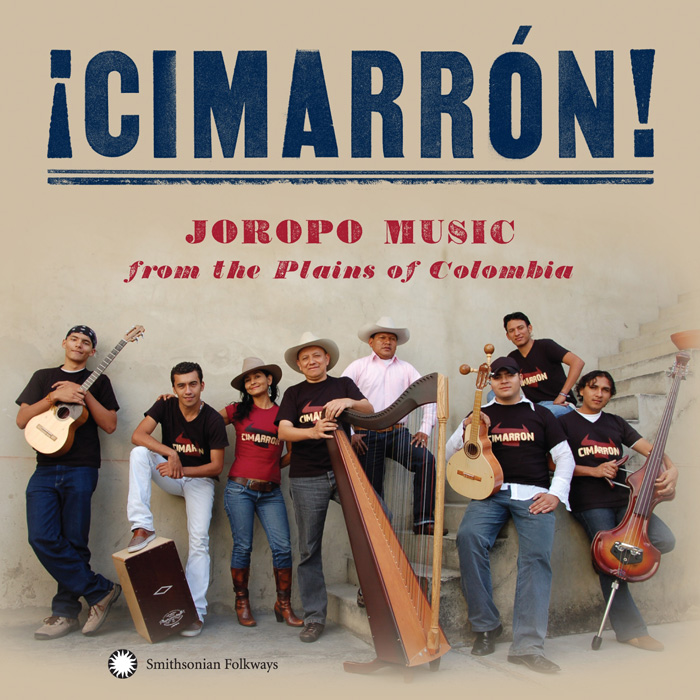
“Vine a defender lo mío (I Came to Defend My Own)”
from ¡Cimarrón! Joropo Music from the Plains of Colombia (2011) | SFW40557
- Pass out shakers. Listen to the “Vine a defender lo mío” recording.
- Before playing the recording ask students to listen especially for the tempo of this song: is it fast or slow?
- Use shakers to shake along with the subdivision of the beat
- Is the singer’s delivery of the text slow or quick?
- What allows the singer to deliver the text so quickly? (Think about vocal placement: is the focus more nasal and forward or dark and back?)
- Discuss the cultural background surrounding this style of performing.
- See liner notes regarding the concurso de voz recia or the “fast song contest”
- Show a picture and give biographical information on Luis Moreno, the singer in this recording (also found in the liner notes)
- Share the general translation of the text.
- From my pretty plain,/I’m the favorite singer./In the “fast song,”/I’m the one of the chosen few./And he who’d say otherwise,/let him come, and I will challenge him.
- Ask students if there are other cultural practices that use nonviolent verbal/musical expression as a form of competition (rap battles, krumping, poetry slam, etc.)
- If possible, find relevant and appropriate videos of these other forms of nonviolent musical expression to share with the class via the internet
- Have students identify one quality within themselves they are proud of or gives them a sense of accomplishment.
- Have each student write one verse (8 lines) expressing his or her talent
- The students may then choose to put an accompanying melody to their verse or choose to speak it rhythmically
- Should students choose to compose a melody for their verse, encourage them to keep the melody within the range of a fifth for both time purposes and ease of performance
- The ultimate goal is to recite the verse as quickly as possible while still maintaining the clarity of delivery
- Warm-up/vocalize (vocal sirens may be helpful)
- Focus on utilizing the resonance of the nasal cavity
- Pair up and recite verses to peers as practice
- Those who wish may compete in the “fast song contest”.
- Designate a timer
- Individuals perform and are timed
- The fastest, clearest performer is deemed the winner
Assessment:
Are students able to identify the tempo of the song as fast? Are students able to discuss the material in an age appropriate manner? Are students able to successfully write their own verse of a “fast song” and perform it?


